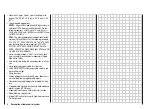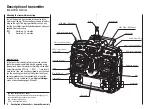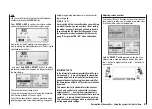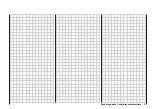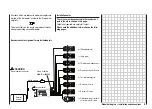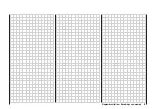
22
Using the receiving system for the fi rst time
Using the receiving system for the fi rst time
Channel selection
Receiving system
The mx-16s radio control set is supplied complete with
a PLL-SCAN narrow-band FM superhet receiver on the
35 / 35B MHz band or the 40 / 41 MHz band. The follo-
wing section describes how to set the receiver channel
to match the transmitter’s channel. The approved chan-
nels at the time of going to press are listed in the table
on page 113.
If you are using the standard receiver, you need to set
the transmitter to PPM transmission mode. You must not
activate the channel on the transmitter until you have
checked carefully that no other pilot is fl ying his model
on your chosen frequency. When you are sure, switch
the receiver on. You will see a blue LED light up on the
receiver, indicating that the unit is (basically) ready for
use.
Setting the receiver to match the transmitter chan-
nel
1. Prepare the transmitter ready for use, with the aerial
fi tted and extended, and place it in the immediate vi-
cinity of the receiver. The scan program which is run
next binds the receiver to the most powerful trans-
mitter signal, so you must ensure that no other radio
control transmitter is located very close to your recei-
ver.
2. Locate the push-button marked “SCAN” on the recei-
ver, and use a tool such as a ball-point pen to hold
the button pressed in until the LED goes out; this
takes about three seconds.
3. Press the SCAN button again immediately when the
LED goes out: the LED now fl ashes at a high rate.
This indicates that the “Scan” process is under way.
As soon as the receiver “fi nds” the transmitter fre-
quency, the LED will glow again constantly. The re-
ceiver stores this channel, so that you do not need to
repeat the process each time you switch the receiver
on; you only need to do this if you change channels.
4. If the LED fl ashes slowly after a few seconds, it is un-
able to lock onto the transmitter frequency. Check the
transmitter, then repeat steps 1 to 3.
Always carry out a range check with the model on the
ground before every fl ight.
Note:
If you wish to connect a servo in parallel with the recei-
ver battery, i.e. to the socket on the R16SCAN recei-
ver marked “8/Batt”, you need to use a Y-lead, Order No.
3936.11
or
3936.32
. As the socket is now in use for two
purposes, Diagnosis mode operations (see pages 15 …
16) are not possible with this receiver.
Please read the information on installing the receiver
and receiver aerial on pages 3 to 5 of these instructions.
If you wish to use a different
GRAUPNER
receiver, ple-
ase note that you must set the appropriate transmission
mode (PPM or SPCM) on the transmitter; the frequen-
cy band and channel number of the receiver must also
match those of the transmitter.
The receiver is fi tted with polarised connector sockets,
so that the servos and battery can only be connected
the right way round. Genuine
GRAUPNER
plugs feature
a slight chamfer on one side to match the sockets. Con-
nect the receiver battery to the receiver socket marked
“8/Batt” via an ON / OFF switch harness.
Note:
If you wish to use a receiver battery and a speed cont-
roller with integral BEC* system, the positive (red) wire
must normally be disconnected from the 3-pin plug, alt-
hough this does vary accor-
ding to the type of control-
ler. Please be sure to read
the instructions supplied with
your speed controller before
you do this.
Using a small screwdriver, carefully raise the centre lug
of the plug (1), withdraw the red wire (2) and insulate the
exposed contact with insulating tape to prevent possible
short-circuits (3).
1
2
3
red
* Battery Elimination Circuit
7
6
5
4
3
2
1
8/
Ba
tt.
PLL-Synthesizer-MICRO-SUPERHET
R 1 6
FM
Best.-Nr.
7052
Kanal 60-282/182-191
für das 35MHz/35MHz-B-Band
S
C
A
N
L
E
D
Made in Malaysia
S C A N
! #
LE
D
S
C
A
N
Antenne
Summary of Contents for MX-16S
Page 1: ...1...
Page 17: ...17...
Page 31: ...31 Fixed wing models Installation and connections...
Page 35: ...35 Program description Reserving a new memory...
Page 47: ...47 Base settings Model helicopter...
Page 83: ...83 Fail safe...
Page 89: ...89 Programming examples Fixed wing model...
Page 109: ...109 Programming examples Model helicopter...
Page 112: ...112 112...
Page 116: ...116...

